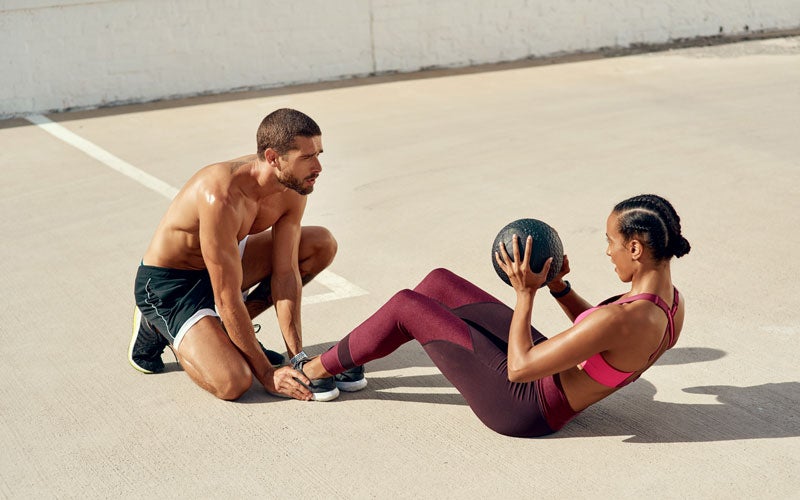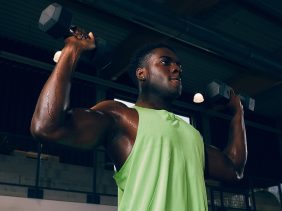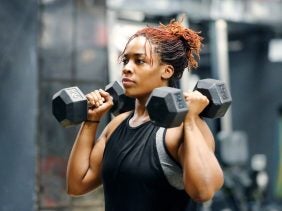How to Get the Tighter Abs You’ve Always Wanted
 © Gettyimages
© Gettyimages
It’s easy to look at the actors in superhero movies and emulate the crazy shape the actors are in. Let’s be honest: if your abs are cutting through your bodysuit, it means that either a) you are gifted with some amazing genes, or b) the studio hired you a world-class trainer and you haven’t eaten past 7 p.m. in the last six months. If you’re willing to go the extra mile—maybe many miles—you can develop those crazy-ass abs, too. If your folks had some serious muscle definition and passed it down, all the better.
How can you build your abs?
To develop your ab muscles, there are two things you need to do, neither of which are going to surprise you. First, you need to work out your whole body, not just the area you want to improve. That’ll help adjust your body composition. As will step number two: locking in your diet. If you have less body fat, it’ll allow your muscles to be closer to the skin, and thus more visible.
You can use our Body Check function to figure out your goals and how to get there.
Abs: The Basics
- We use our abs to stabilize our core.
- All abdominal muscles should be engaged at once.
- It’s important to balance training your core and abdominal muscles with training your back muscles to maintain a healthy posture.
Related: See your six-pack with these five moves
Ab Workouts: How to do them correctly
There are many different workouts for abs. However, it’s important to build a training program that works for you — preferably something you’re at least a little familiar with so you’re not totally in the dark when you get started. That way you’ll be able to tell when you’ve made progress and make adjustments as necessary, whether that’s adding more weight or doing more repetitions. After you’ve been doing the same program for a few weeks, we always advise updating your workout to reflect the progress you’ve made, so that your muscles continue to develop rather than stagnate.
Since the abdominal muscles are part of the core of our bodies, they keep our upper bodies stabilized all the time — when you’re standing, walking, or even sitting. That’s why it’s so important to have this group of muscles well trained.
Some of the best abs exercises include crunches, sit-ups, leg lifts, bicycle crunches, Russian twists, and plank position. These will work the central and oblique ab muscles and ensure good muscle definition.
But to really ensure you see the results you’re looking for, it’s important to combine these targeted ab exercises with regular cardio exercise including high intensity interval training.
Related: Ultimate full body HIIT workout
Whey Protein – Perfect for after your six-pack workout
When you work out, you ask everything from your body. So it’s only fair to give it back the very best. Our Whey Protein contains the perfect whey formula for your ab muscles. And if you’re plant-based, we have got you covered.
If you follow the workouts of those movie stars, they’ll talk about changing their body composition to lose fat. As with many factors that affect the human body, it’s difficult to know exactly how much weight you need to lose to develop abs. Women have, by nature, more body fat than men, and everyone loses and gains weight differently, so it can be really hard to know how your body will react. Very generally, you’re looking at 16 to 20 percent for women and 10 to 14 percent for men.
Once again, this isn’t necessarily true for everyone. Our bodies are all different and some people store fat in different areas than others. For example, if you tend to store more fat in your hips, you may have an easier time developing abs than someone who stores fat in their belly. But obviously you don’t have a choice where it’s stored, so it’s not up to you where it goes.
The most effective exercises for abs
There are lots of exercises to help you tighten your core! You can totally vary or increase the degree of difficulty or work with extra weights. Choose an abs workout from one of these:
1. HIGH KNEES
Start in a standing position. Begin running in place, focusing on bringing knees up to belly button height or higher, while swinging arms. If this is too challenging, lift one leg and replace it, then lift the other leg, focusing on bringing the knees high but not working speedily.
2. SIT-UPS
Lay on back, knees at a 45° angle, feet on floor, hands lightly cupping ears, elbows out to sides, to start. Engage abs and draw shoulder blades as high off the floor until chest reaches knees, then reverse to start for one rep. Can be done with feet anchored by a weight or a workout buddy.
3. PLANK
Start in a low plank, forearms on floor, elbows under shoulders, heels making a straight line with legs, back, and head. Keeping gaze toward the ground, hold for the duration of the rep. If that’s too hard, try a high plank with hands on the floor, or drop to knees. If it’s too easy, do longer sets.
4. LEG RAISES
Lie on back, hands to the sides, feet together. Raise legs a few inches and press fingertips into floor to start. Keeping legs locked out, feet flexed, low back touching the floor, draw legs straight up until bottom of feet are parallel with the ceiling and but comes off floor slightly. Return to start and repeat continuously.
5. RUSSIAN TWISTS WITH OR WITHOUT WEIGHTS
Sit holding a light weight plate, kettlebell, or dumbbell. Sit on floor, legs bent at a 45° angle, heels on the floor, toes up. Start by lifting heels about six inches off floor and rotate the weight across your torso to the side of your body and back continuously. If that’s too hard, leave feet on floor. If that’s too easy, increase the weight.
6. CRUNCHES
Lie on floor, knees bent, feet on floor, hands lightly holding head behind ears, to start. Keeping a neutral neck, lift torso and shoulder blades off floor, chin pointed to ceiling, then return to start. Repeat continuously.
Fancy a snack: Try our protein balls
More healthy living tips from foodspring:
- More performance in the gym through mobility training
- The #1 Reason Your Muscles Aren’t Growing
- 6 Surprising Effects Lifting Weights, According to Science
- Push & Pull – The Only 6 Moves Your Need to Know to Build Strength
Sources for this article
We at foodspring use only high-quality sources, including peer-reviewed studies, to support the facts within our articles. Read our editorial policy to learn more about how we fact-check and keep our content accurate, reliable, and trustworthy.

































